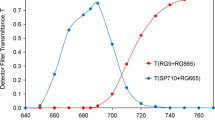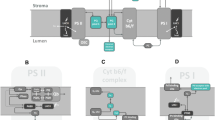Abstract
The initial (F0), maximal (FM) and steady-state (FS) levels of chlorophyll fluorescence emitted by intact pea leaves exposed to various light intensities and environmental conditions, were measured with a modulated fluorescence technique and were analysed in the context of a theory for the energy fluxes within the photochemical apparatus of photosynthesis. The theoretically derived expressions of the fluorescence signals contain only three terms, X=J2p2F/(1−G), Y=T/(1−G) and V, where V is the relative variable fluorescence, J2 is the light absorption flux in PS II, p2F is the probability of fluorescence from PS II, G and T are, respectively, the probabilities for energy transfer between PS II units and for energy cycling between the reaction center and the chlorophyll pool: F0=X, FM=X/(1−Y) and FS=X(1+(YV/(1−Y))). It is demonstrated that the amplitudes of the previously defined coefficients of chlorophyll fluorescence quenching, qP and qN, reflect, not just photochemical (qP) or nonphotochemical (qN) events as implied in the definitions, but both photochemical and nonphotochemical processes of PS II deactivation. The coefficient qP is a measure of the ratio between the actual macroscopic quantum yield of photochemistry in PS II (41-1) in a given light state and its maximal value measured when all PS II traps are open (41-2) in that state, with 41-3 and 41-4. When the partial connection between PS II units is taken into consideration, 1-qP is nonlinearily related to the fraction of closed reaction centers and is dependent on the rate constants of all (photochemical as well as nonphotochemical) exciton-consuming processes in PS II. On the other hand, 1-qN equals the (normalized) ratio of the rate constant of photochemistry (k2b) to the combined rate constant (kN) of all the nonphotochemical deactivation processes excluding the rate constant k22 of energy transfer between PS II units. It is demonstrated that additional (qualitative) information on the individual rate constants, kN-k22 and k2b, is provided by the fluorescence ratios 1/FM and (1/F0)−(1/FM), respectively. Although, in theory, 41-5 is determined by the value of both k2b and kN-k22, experimental results presented in this paper show that, under various environmental conditions, 41-6 is modulated largely through changes in k N, confirming the idea that PS II quantum efficiency is dynamically regulated in vivo by nonphotochemical energy dissipation.
Similar content being viewed by others
Abbreviations
- Chl:
-
chlorophyll
- F0, FM and FS :
-
initial, maximal and steady-state levels of modulated Chl fluorescence emitted by light-adapted leaves
- PS I and II:
-
photosystem I and II
- qP and qN :
-
(previously defined) photochemical and nonphotochemical components of Chl fluorescence quenching
References
Baltscheffsky M (ed) (1990) Current Research in Photosynthesis. Dordrecht: Kluwer
Bilger W and Schreiber U (1986) Energy-dependent quenching of dark-level chlorophyll fluorescence in intact leaves. Photosynth Res 10: 303–308
Bolhàr-Nordenkampf HR, Long SP, Baker NR, Öquist G, Schrieber U and Lechner EG (1989) Chlorophyll fluorescence as a probe of the photosynthetic competence of leaves in the field: a review of current instrumentation. Funct Ecol 3: 497–514
Briantais J-M, Vernotte C, Krause GH and Weis E (1986) Chlorophyll a fluorescence of higher plants: chloroplasts and leaves. In: Govindjee et al. (eds) Light Emission by Plants and Bacteria, pp 539–583. New York: Academic Press
Buschmann C (1987) Induction kinetics of heat emission before and after photoinhibition in cotyledons of Raphanus sativus. Photosynth Res 14: 229–240
Butler WL and Kitajima M (1975) Energy transfer between photosystem II and photosystem I in chloroplasts. Biochim Biophys Acta 396: 72–85
Butler WL and Strasser RJ (1977) Tripartite model for the photochemical apparatus of green plant photosynthesis. Proc Natl Acad Sci USA 74: 3382–3385
Butler WL (1978) Energy distribution in the photochemical apparatus of photosynthesis. Annu Rev Plant Physiol 29: 345–378
Cao J and Govindjee (1990) Chlorophyll a fluorescence transients as an indicator of active and inactive Photosystem II in thylakoid membranes. Biochim Biophys Acta 1015: 180–188
Fork DC and Satoh K (1986) The control by state transitions of the distribution of excitation energy in photosynthesis. Annu Rev Plant Physiol 37: 335–361
Genty B, Briantais J-M and Baker NR (1989) The relationship between the quantum yield of photosynthetic electron transport and quenching of chlorophyll fluorescence. Biochim Biophys Acta 990: 87–92
Guenther JE, Nemson JA and Melis A (1990) Development of PS II in dark grown Chlamydomonas reinhardtii. A light-dependent conversion of PS IIβ, QB-non reducing centers to PS IIα, QB-reducing form. Photosynth Res 24: 35–46
Havaux M, Ernez M and Lannoye R (1988) Correlation between heat tolerance and drought tolerance in cereals demonstrated by rapid chlorophyll fluorescence tests. J Plant Physiol 133: 555–560
Havaux M (1989) Increased thermal deactivation of excited pigments in pea leaves subjected to photoinhibitory treatments. Plant Physiol 89: 286–292
Havaux M (1990) ‘Energy’-dependent quenching of chlorophyll fluorescence and thermal energy dissipation in intact leaves during induction of photosynthesis. Photochem Photobiol 51: 481–486
Horton P and Hague A (1988) Studies on the induction of chlorophyll fluorescence in isolated barley protoplasts. IV. Resolution of non-photochemical quenching. Biochim Biophys Acta 932: 107–115
Horton P (1990) Regulation of light harvesting by metabolic events. In: Baltscheffsky M (ed) Current Research in Photosynthesis, Vol IV, pp 111–118. Dordrecht: Kluwer Acad Publ
Joliot A and Joliot P (1964) Etudes cinétiques de la réaction photochimique libérant l'oxygène au cours de la photosynthèse. CR Acad Sci Paris 258: 4622–4625
Kitajima M and Butler WL (1975) Quenching of chlorophyll fluorescence and primary photochemistry in chloroplasts by dibromothymoquinone. Biochim Biophys Acta 376: 105–115
Krause GH, Vernotte C and Briantais J-M (1982) Photoinduced quenching of chlorophyll fluorescence in intact chloroplasts and algae. Resolution into two components. Biochim Biophys Acta 679: 116–124
Krause GJ and Weis E (1984) Chlorophyll fluorescence as a tool in plant physiology. II. Interpretation of fluorescence signals. photosynth Res 5: 139–157
Krause GH (1988) Photoinhibition of photosynthesis. An evaluation of damaging and protective mechanisms. Physiol Plant 74: 566–574
Krause GH, Laasch H and Weis E (1988) Regulation of thermal dissipation of absorbed light energy in chloroplasts indicated by energy-dependent fluorescence quenching. Plant Physiol Biochem 26: 445–452
Lavorel J and Etienne A-L (1977) In vivo chlorophyll fluorescence. In: Barber J (ed) Primary Processes of Photosynthesis, pp 203–268. Amsterdam: Elsevier Science Publ
Lichtenthaler HK (ed) (1988) Applications of Chlorophyll Fluorescence. Dordrecht: Kluwer Acad Publ
Ludlow MM (1987) Light stress at high temperature. In: Kyle DJ, Osmond CB and Arntzen CJ (eds) Photoinhibition, pp 89–109. Amsterdam: Elsevier Science Publ
Ludlow MM and Powles SB (1988) Effects of photoinhibition induced by water stress on growth and yield of grain sorghum. Aust J Plant Physiol 15: 179–194
Malkin S and Kok B (1966) Fluorescence induction studies in isolated chloroplasts. I. Number of components involved in the reaction and quantum yields. Biochim Biophys Acta 126: 413–432
Malkin S, Telfer A and Barber J (1986) Quantitative analysis of State 1-State 2 transitions in intact leaves using modulated fluorimetry — evidence for changes in the absorption cross-section of the two photosystems during state transitions. Biochim Biophys Acta 848: 48–57
Schrieber U, Schliwa U and Bilger W (1986) Continuous recording of photochemical and non-photochemical chlorophyll fluorescence quenching with a new type of modulation fluorometer. Photosynth Res 10: 51–62
Sironval C, Strasser RJ and Brouers M (1984) The bioenergetic description of light energy migration in photoactive membranes; Equivalence between the theory of the energy fluxes and the theory of the proportion of pigments forms to total pigments. In: Sironval C and Brouers M (eds) Protochlorophyllide Reduction and Greening, pp 307–316. Martinus Nijhoff/Junk: The Hague.
Strasser RJ and Butler WL (1977) Energy coupling in the photosynthetic apparatus during development. In: Hall DO, Coombs J and Goodwin TW (eds) Proc 4th Internat Congress on Photosynthesis 1977, pp 527–535. The Biochemical Society: London
Strasser RJ (1978) The grouping model of plant photosynthesis. In: Akoyunoglou G et al. (eds) Chloroplast Development, pp 513–524. Amsterdam: Elsevier Science Publ
Strasser RJ (1981) The grouping model of photosynthesis: heterogeneity of photosynthetic units in thylakoids. In: Akoyunoglou G (ed) Photosynthesis. Proc 5th Internat Congress on Photosynthesis, Vol III, pp 727–737. Balaban International Science Services: Philadelphia
Strasser RJ (1985) Dissipative Strukturen als thermodynamischer Regelkreis des Photosyntheseapparates. Ber deutsch Bot Ges Bd 98: 53–72.
Velthuys BR (1987) The photosystem two reaction center. In: Barber J (ed) The Light Reactions, pp 341–377. Amsterdam: Elsevier Science Publ
Weis E and Berry JA (1987) Quantum efficiency of photosystem II in relation to ‘energy’-dependent quenching of chlorophyll fluorescence. Biochim Biophys Acta 894: 198–208
Williams WP (1977) The two photosystems and their interactions. In: Barber J (ed) Primary Processes of Photosynthesis, pp 99–147. Amsterdam: Elsevier Science Publ
Author information
Authors and Affiliations
Rights and permissions
About this article
Cite this article
Havaux, M., Strasser, R.J. & Greppin, H. A theoretical and experimental analysis of the qP and qN coefficients of chlorophyll fluorescence quenching and their relation to photochemical and nonphotochemical events. Photosynth Res 27, 41–55 (1991). https://doi.org/10.1007/BF00029975
Received:
Accepted:
Issue Date:
DOI: https://doi.org/10.1007/BF00029975




